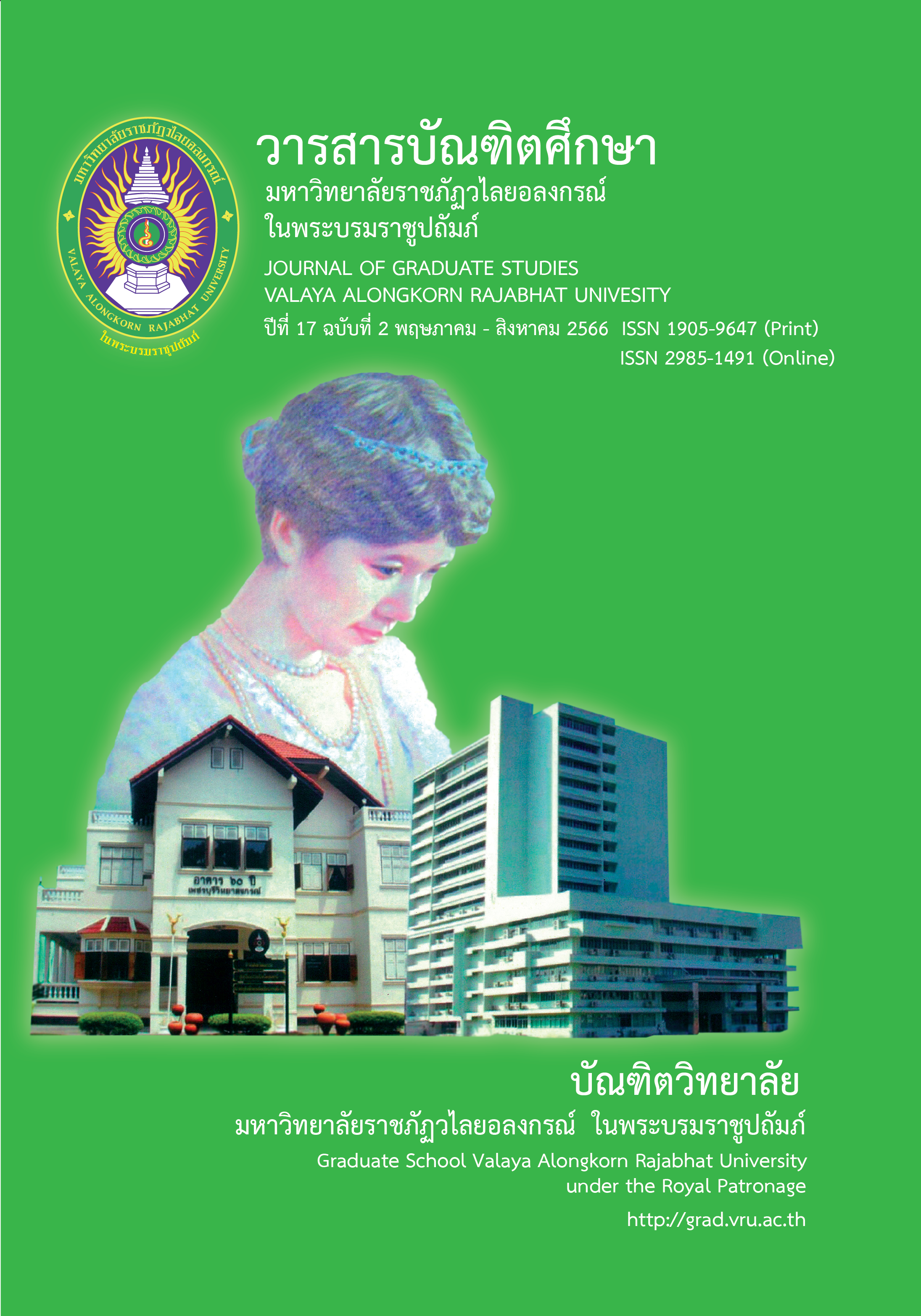ผลการจัดการเรียนรู้โดยใช้กลยุทธ์การอ่านเชิงรุกและเทคนิคการให้ผลประเมินป้อนกลับโดยเพื่อน เพื่อพัฒนาความสามารถในการอ่านและการเขียนเชิงวิชาการของนักศึกษาครู
Main Article Content
บทคัดย่อ
การวิจัยนี้มีวัตถุประสงค์เพื่อ 1) เปรียบเทียบความสามารถในการอ่านเชิงวิชาการของนักศึกษาก่อนเรียนและหลังเรียน 2) ศึกษาการใช้กลยุทธ์การอ่านเชิงรุกของนักศึกษาที่มีผลต่อการพัฒนาการอ่านเชิงวิชาการ และ 3) เปรียบเทียบความสามารถในการเขียนเชิงวิชาการของนักศึกษาก่อนเรียนและหลังเรียน กลุ่มเป้าหมาย คือ นักศึกษาหลักสูตรครุศาสตรบัณฑิต สาขาวิชาภาษาไทย ชั้นปีที่ 3 ภาคการศึกษาที่ 2 ปีการศึกษา 2563 จำนวน 30 คน วิธีการวิจัยกึ่งทดลอง แบบแผนการวิจัยกลุ่มเดียวทดสอบก่อน-หลัง เครื่องมือที่ใช้ในการวิจัย ได้แก่ แผนการจัดการเรียนรู้ แบบทดสอบความสามารถในการอ่านเชิงวิชาการ ประเด็นการสนทนากลุ่ม แบบทดสอบความสามารถในการเขียนเชิงวิชาการ ดำเนินการเก็บรวบรวมและวิเคราะห์ข้อมูลด้วยวิธีการแบบผสมผสาน ทั้งเชิงปริมาณและคุณภาพ โดยใช้ค่าร้อยละ ค่าเฉลี่ย ค่าส่วนเบี่ยงเบนมาตรฐาน และการวิเคราะห์เนื้อหา
ผลการวิจัยพบว่า 1) ความสามารถในการอ่านเชิงวิชาการของนักศึกษาหลังเรียนโดยใช้กลยุทธ์การอ่านเชิงรุกและเทคนิคการให้ผลประเมินป้อนกลับโดยเพื่อนสูงกว่าก่อนเรียน 2) ผลการ ศึกษาการใช้กลยุทธ์การอ่านเชิงรุกของนักศึกษา พบว่า นักศึกษาเลือกใช้กลยุทธ์การอ่านเชิงรุก จำนวน 12 กลยุทธ์ แบ่งออกเป็น 3 กลุ่ม ได้แก่ (1) กลยุทธ์อภิปัญญา (2) กลยุทธ์การอ่านเพื่อสร้างความรู้ความเข้าใจ (3) กลยุทธ์การอ่านเพื่อขยายความรู้ความเข้าใจ ตามลำดับ โดยมีวัตถุประสงค์ในการใช้กลยุทธ์การอ่านเชิงรุกเพื่อส่งเสริมความสามารถในการอ่านเชิงวิชาการ 10 องค์ประกอบ และมีผลต่อการพัฒนาการอ่านเชิงวิชาการของนักศึกษาในด้าน (1) การใช้กลยุทธ์การอ่านที่หลากหลาย (2) การปรับตัว ควบคุม ชี้นำตนเองในการอ่าน (3) การอ่านอย่างหลากหลาย (4) การจัดการเวลาการอ่าน (5) การอ่านอย่างต่อเนื่อง ตามลำดับ 3) ความสามารถในการเขียนเชิงวิชาการของนักศึกษาหลังเรียนโดยใช้กลยุทธ์การอ่านเชิงรุกและเทคนิคการให้ผลประเมินป้อนกลับโดยเพื่อนสูงกว่าก่อนเรียน
Article Details

อนุญาตภายใต้เงื่อนไข Creative Commons Attribution-NonCommercial-NoDerivatives 4.0 International License.
บทความทุกเรื่องได้รับการตรวจความถูกต้องทางวิชาการโดยผู้ทรงคุณวุฒิ ทรรศนะและข้อคิดเห็นในบทความวารสารบัณฑิตศึกษา มหาวิทยาลัยราชภัฏวไลยอลงกรณ์ ในพระบรมราชูปถัมภ์ มิใช่เป็นทรรศนะและความคิดของผู้จัดทำจึงมิใช่ความรับผิดชอบของบัณฑิตวิทยาลัย มหาวิทยาลัยราชภัฏวไลยอลงกรณ์ ในพระบรมราชูปถัมภ์ กองบรรณาธิการไม่สงวนสิทธิ์การคัดลอก แต่ให้อ้างอิงแหล่งที่มา
เอกสารอ้างอิง
Abdelhalim, S. M. (2017). Developing EFL students’ reading comprehension and reading engagement: effects of a proposed instructional strategy. Theory and Practice in Language Studies. 7(1), 37-48.
Anderson, Anson, Gonyea & Paine. (2016). How to create high impact writing assignments that enhance learning and development and reinvigorate WAC/WID Programs: What Almost 72,000 Undergraduates Taught Us. A Journal of Language, Learning and Academic Writing. Retrieved from https://doi.org/10.37514/ATD-J.2016.13.4.13
Anderson, N. J. (2015). Academic reading expectations and challenges. esl reader and writers in higher education. New York: Routledge.
Anderson, N. J. (2020). Promoting Reading with the ACTIVE framework for the american english live teacher professional development series. Retrieved from https://americanenglish.state.gov/files/ae/resource_files/ae_live_8.1_active_reading-presentation.pdf
Bean, J. C. (2011). Engaging ideas: The professor's guide to integrating writing, critical thinking, and active learning in the classroom. 2nd ed. San Francisco, CA: Jossey-Bass.
Chitez, M. & Kruse, O. (2012). Writing cultures and genres in European higher education in Montserrat Castello & Christiane Donahue (Ed.), University Writing: Selves and Texts in Academic societies. UK: Emerald group Publishing Limited.
Corrigan, P. T. (2014). Attending to the act of reading: critical reading, contemplative reading and active reading. Essays in Reader Oriented Theory, Criticism, and Pedagogy. 63(64), 146-173.
Dirgeyasa, M. H. (2016). College academic writing a genre-based perspective. Jakarta: KECANA.
Douglas, K., Barnett, T., Poletti, A. Seaboyer, J. & Kennedy, R. (2016). Building reading resilience: Re-thinking reading for the literary studies classroom. Higher Education Research & Development. 35(2), 254-266.
Frey, N., Fisher, D. & Hattie, J. (2016). Surface, deep, and transfer? considering the role of content literacy instructional strategies. Journal of Adolescent & Adult Literacy. 60(5), 567-575.
Giltrow, J., Gooding, R. & Burgoyne, D. (2021). Academic writing an introduction. 4th ed. Ontario: Broadview Press.
Goctu, R. (2017). Metacognitive strategies in academic writing. Journal of Education in Black Sea Region. 2(2), 82-96.
Hu, G. (2019). Culture and peer feedback. In K. Hyland & F. Hyland (Eds.), Feedback in second language writing: Contexts and issues (45-63). Cambridge, UK: Cambridge University Press.
Huisman, B., Saab, N., Driel, J. V. & Broek, P. V. D. (2018). Peer feedback on academic writing: undergraduate students’ peer feedback role, peer feedback perceptions and essay performance. Assessment & Evaluation in Higher Education. 43(6), 955-968.
Inie, N. & Barkuus, L. (2021). Developing evaluation metrics for active reading support. In Proceedings of the 13th International Conference on Computer Supported Education (CSEDU 2021). 1, 177-188.
Jennifer, A. P. (2017). Multimedia active reading: a framework for understanding learning with tablet textbook. in Terry Kidd & Lonnie R. Morris, Jr. (Ed.), Handbook of Research on Instructional systems in educational Technology (pp. 153-163). United States of America: IGI Global.
Kunwongse, S. (2013). Peer feedback, benefits and drawbacks. Thammasat Review. Special Issue, 277-288.
Liu, X., Gu, M. M. & Jin, T. (2021). Strategy use in collaborative academic reading: Understanding how undergraduate students co-construct comprehension of academic texts. Language Teaching Research. Retrieved from https://journals.sagepub.com/doi/10.1177/13621688211025688
Lumen. (2020). Active reading strategies. Retrieved from https://courses.lumenlearning.com/
Manarin, K. (2019). Why Read?. Higher Education Research & Development. 38(1), 11-23.
Miller, K., Lukoff, B. & Mazur, E. (2018). Use of a social annotation platform for pre-class reading assignment in flipped introductory physic class. Frontiers in Education. 3, 1-12.
Roy, N., Torre, M. V., Gadiraju, U., Maxwell, D., & Hauff, C. (2021). How do active reading strategies affect learning outcomes in web search?. Retrieved from https://doi.org/10.1007/978-3-030-72240-1_37
Sackstein, S. (2017). Peer feedback in the classroom: empowering students to be the experts. Verginia: ASCD.
Saengpakdeejit, R. (2011). Use of reading strategies in English academic reading. RMUTP Research Journal. 5(1), 76-90.
Satjapiboon, S. (2010). Development of an instructional model by integrating process-based, content-based, and genre-based approach for enhancing academic writing and critical thinking ability of undergraduate students. Doctoral dissertation. Chulalongkorn University.
Shulin, Y. & Lee, I. (2016). Peer feedback in second language writing (2005-2014). Language Teaching. 49(4), 461-493.
Singh, M. K. M. (2015). International graduate student’ academic writing practices in malaysia: challenges and solutions. Journal of International Students. 5(1), 12-22.
Snow, E. L., Jacovina, M. E., Jackson, G. T. & McNamara, D. S. (2016). iSTART-2 A Reading comprehension and strategy instruction tutor. In S. A. Crossley & D.S. McNamara (Eds.) In Adaptive educational technologies for literacy instruction (104-121). New York: Taylor & Francis.
Sukavatee, P. (2017). The use of reading strategies to enhance critical reading ability through a blended learning environment of English major students at the faculty of education. Journal of Education Studies Chulalongkorn University. 45(2), 72-89.
Sun, T. T. (2020). Active versus passive reading: Hoe to read scientific paper?. National Science Review. 7(9), 1422-1427.
Torshizi, D. M. & Bahraman, M. (2019). I explain, therefore I learn: Improving students’ assessment literacy and deep learning by teaching. Studies in Educational Evaluation. 61, 66-73.
Western Sydney. (2017). How to read effectively. Retrieved from westernsydney.edu.au/studysmart
Zemach, D. E. & Rumisek, L. A. (2010). Academic writing from paragraph to essay. Berlin: Hueber Veriag Gmbh.


